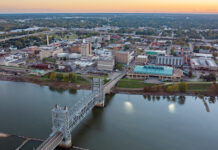
The American Planning Association (APA) has announced the designation of Fifth Avenue as one of 10 Great Streets for 2012 under the organization’s Great Places in America program. APA Great Places exemplify exceptional character and highlight the role planning and planners play in adding value to communities, including fostering economic growth and jobs.
APA singled out Fifth Avenue for its wealth of historic buildings and districts; vast array of commercial, retail, residential, religious, recreational and cultural uses; and reliance on planning and zoning to guide growth. This expansive and majestic street runs six miles in a southerly direction from Marcus Garvey Park in Harlem to Washington Square in lower Manhattan.
“With its vibrant, bustling street life, historic and unique architecture and innovative planning,” New York City Planning Commissioner Amanda M. Burden said, “Fifth Avenue exemplifies what makes New York a great city. Stretching for more than 100 blocks and through 11 neighborhoods, Fifth Avenue is an iconic cultural and commercial center that continues to evolve and change with the pace of the city. I am proud that the American Planning Association has chosen Fifth Avenue as one of this year’s Great Streets in America.”
Through Great Places in America, APA recognizes streets, neighborhoods, and public spaces featuring unique and authentic characteristics that have evolved from years of thoughtful and deliberate planning by residents, community leaders and planners. The 2012 Great Places illustrate how the foresight of planning fosters tomorrow’s communities and they have many of the features Americans say are important to their “ideal community” including locally owned businesses, transit, neighborhood parks, and sidewalks.
Since APA began Great Places in America in 2007, 60 neighborhoods, 60 streets and 50 public spaces have been designated in 50 states and the District of Columbia.
“Fifth Avenue evokes a sense of style and splendor that is virtually unparalleled in the U.S.,” said APA Chief Executive Officer Paul Farmer, FAICP. “While home to one of the world’s most exciting shopping districts, Fifth Avenue is no less important as a cultural and educational mecca and architectural wonderland thanks to the city’s rich tradition of planning and implementing its plans,” he added.
Fifth Avenue gained some prominence in the 1811 Commissioner’s Plan, which formally established Manhattan’s street grid, in that it serves as the dividing line for the island’s east and west sides and the zero point for street addresses. Numbers increase in both directions as one moves away from Fifth Avenue.
The avenue’s celebrity commenced in 1862 when socialite Caroline Schermerhorn Astor and her husband built a townhouse at Fifth and 34th Street in today’s midtown. Three decades later, the Astoria Hotel rose on that site as the area began to commercialize. Diagonally across Fifth Avenue from the hotel was an 1896 structure that became the street’s premiere retail building a decade later. When B. Altman and Company opened its signature department store there, it launched Fifth Avenue’s reputation as an upscale shopping district.
Commercial construction drove residential development north. Palatial homes lined the east side of upper Fifth Avenue, between 59th and 96th Streets, taking advantage of the picturesque view afforded by Frederick Law Olmsted’s expansive Central Park. Open space requirements, height restrictions and use designations were put in place in 1916 to limit shadowing of the public realm when the city adopted the nation’s first zoning ordinance.
Several of Fifth Avenue’s historic residences eventually were converted to museums. The Cooper-Hewitt National Design Museum is housed in a mansion once owned by steel tycoon Andrew Carnegie while the Museum of the City of New York occupies space in a handsome 1932 property. The Metropolitan Museum of Art and Frank Lloyd Wright’s Guggenheim Museum are found along the Museum Mile, which extends north from 82nd Street.
The New York City Landmarks Preservation Commission, formed in 1965, has been instrumental in protecting Fifth Avenue’s limestone buildings, such as the 1911 Beaux Arts New York City Public Library, and historic areas along the street including the Greenwich Village historic district between Washington Square Park and 12th Street. Further north – on a triangular lot at the confluence of Fifth, Broadway, and East 22nd St. – is the landmark Flatiron building built in 1902 and at the time one of the city’s tallest skyscrapers. Numerous other landmarks and historic districts call Fifth Avenue home, including the 1878 Neo-Gothic Cathedral of Saint Patrick, the 1931 Art Deco Empire State Building and Rockefeller Center’s 1939 complex of 19 Art Deco buildings.
Planning efforts have contributed to Fifth Avenue’s status as a Great Street, gaining steam after the Fifth Avenue Association, formed by merchants and property owners in 1907, began lobbying for zoning regulations to protect against encroaching factories. Various zoning districts, established in 1970, 1973 and 1982, encouraged appropriate new development, maintenance of a continuous street wall, and a focus on retail uses in midtown. The 19-year-old Fifth Avenue Business Improvement District ensures a clean, safe and welcoming environment.
The nine other APA 2012 Great Streets are: Duval Street, Key West, FL; Ward Parkway, Kansas City, MO; Main Street, Bozeman, MT; Broadway, Saratoga Springs, NY; Wall Street, Kingston, NY; Shaker Boulevard, Cleveland, Shaker Heights and Beachwood, OH; Grant Street, Pittsburgh, PA; Broad Street, Charleston, SC; and Gay Street, Knoxville, TN.
















![[VIDEO] Get More for Your Business in Ardmore. Oklahoma](https://businessfacilities.com/wp-content/uploads/2024/02/maxresdefault-324x160.jpg)
